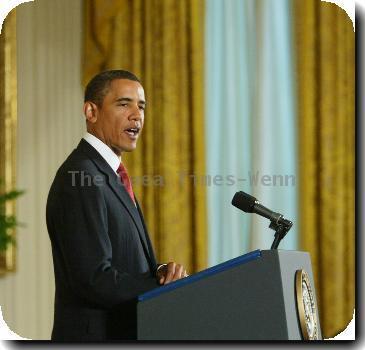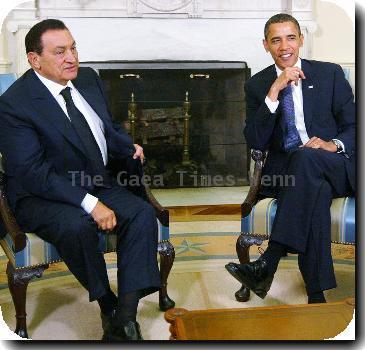US security at stake, Obama declares, ordering 30,000 more troops to Afghanistan war
By Steven R. Hurst, APTuesday, December 1, 2009
30,000-troop boost ordered by Obama in Afghanistan
WEST POINT, N.Y. — Declaring “our security is at stake,” President Barack Obama ordered an additional 30,000 U.S. troops into the long war in Afghanistan on Tuesday night, but balanced the buildup with a pledge to an impatient nation to begin withdrawing American forces in 18 months.
In a prime-time speech at the U.S. Military Academy, the president said his new policy was designed to “bring this war to a successful conclusion.” The troop buildup will begin almost immediately — the first Marines will be in place by Christmas — and will cost $30 billion for the first year alone.
“We must deny al-Qaida a safe haven,” Obama said in articulating U.S. military goals for a war that has dragged on for eight years. “We must reverse the Taliban’s momentum. … And we must strengthen the capacity of Afghanistan’s security forces and government.”
The president said the additional forces would be deployed at “the fastest pace possible so that they can target the insurgency and secure key population centers.”
Their destination: “the epicenter of the violent extremism practiced by al-Qaida.”
“It is from here that we were attacked on 9/11, and it is from here that new attacks are being plotted as I speak,” the president said.
It marked the second time in his young presidency that Obama has added to the American force in Afghanistan, where the Taliban has recently made significant advances. When he became president last January, there were roughly 34,000 troops on the ground; there now are 71,000.
Obama’s announcement drew less-than-wholehearted support from congressional Democrats. Many of them favor a quick withdrawal, but others have already proposed higher taxes to pay for the fighting.
Republicans reacted warily, as well. Officials said Sen. John McCain, who was Obama’s Republican opponent in last year’s presidential campaign, told Obama at an early evening meeting attended by numerous lawmakers that declaring a timetable for a withdrawal would merely send the Taliban underground until the Americans began to leave.
As a candidate, Obama called Afghanistan a war worth fighting, as opposed to Iraq, a conflict he opposed and has since begun easing out of.
A new survey by the Gallup organization, released Tuesday, showed only 35 percent of Americans now approve of Obama’s handling of the war; 55 percent disapprove.
“After 18 months, our troops will begin to come home,” he said flatly.
In eight years of war, 849 Americans have been killed in Afghanistan, Pakistan and neighboring Uzbekistan, according to the Pentagon.
In addition to beefing up the U.S. presence, Obama has asked NATO allies to commit between 5,000 and 10,000 additional troops.
He said he was counting on Afghanistan eventually taking over its own security, and he warned, “The days of providing a blank check are over.” He said the United States would support Afghan ministries that combat corruption and “deliver for the people. We expect those who are ineffective or corrupt to be held accountable.”
As for neighboring Pakistan, the president said that country and the United States “share a common enemy” in Islamic terrorists. He added his policy will be to strengthen Pakistan’s capacity to target terrorists, and he said the U.S. has “made it clear that we cannot tolerate a safe haven for terrorists whose location is known.”
Most of the new forces will be combat troops. Military officials said the Army brigades were most likely to be sent from Fort Drum in New York and Fort Campbell in Kentucky; and Marines primarily from Camp Lejeune in North Carolina.
Officials said the additional 30,000 troops included about 5,000 dedicated trainers, underscoring the president’s emphasis on preparing Afghans to take over their own security. They added the president is making clear to his generals that all troops, even if designated as combat, must consider themselves trainers.
These aides said that by announcing a date for beginning a withdrawal, the president was not setting an end date for the war.
But that was a point on which McCain chose to engage the president at a pre-speech meeting with lawmakers before Obama departed for West Point. “The way that you win wars is to break the enemy’s will, not to announce dates that you are leaving,” McCain said later.
Obama’s address represents the beginning of a sales job to restore support for the war effort among an American public grown increasingly pessimistic about success — and among some fellow Democrats in Congress wary of or even opposed to spending billions more dollars and putting tens of thousands more U.S. soldiers and Marines in harm’s way.
Sen. Russ Feingold, D-Wis., and liberal House Democrats threatened to try to block funding for the troop increase.
Sen. Carl Levin, the Michigan Democrat who chairs a military oversight panel, said he didn’t think Democrats would yank funding for the troops or try to force Obama’s hand to pull them out faster. But Democrats will be looking for ways to pay for the additional troops, he said, including a tax increase on the wealthy although that hike is already being eyed to pay for health care costs. Another possibility is imposing a small gasoline tax that would be phased out if gas prices go up, he said.
If the timeline for the troop increase holds, it will require a costly logistical scramble to send in so many people and so much equipment almost entirely by air. It will also probably require breaking at least an implicit promise to some soldiers who had thought they would have more than 12 months at home before their next deployment.
At the same time, NATO diplomats said Obama was asking alliance partners in Europe to add 5,000 to 10,000 troops to the separate international force in Afghanistan. Indications were the allies would agree to a number somewhere in that range. The war has even less support in Europe than in the United States, and the NATO allies and other countries currently have about 40,000 troops on the ground.
Late Monday, the president spent an hour on a video conference call with Karzai. On Tuesday, he contacted Pakistan President Asif Ali Zardari and, aides said, planned to speak of a need to help Pakistan stabilize itself from the threats it faces not only from al-Qaida but Taliban forces that are increasingly behind terrorist bombings in that country.
The United States went to war in Afghanistan shortly after the Sept. 11, 2001, al-Qaida terrorist attacks on the United States.
Bin Laden and key members of the terrorist organization were headquartered in Afghanistan at the time, taking advantage of sanctuary afforded by the Taliban government that ran the mountainous and isolated country.
Taliban forces were quickly driven from power, while bin Laden and his top deputies were believed to have fled through towering mountains into neighboring Pakistan. While the al-Qaida leadership appears to be bottled up in Pakistan’s largely ungoverned tribal regions, the U.S. military strategy of targeted missile attacks from unmanned drone aircraft has yet to flush bin Laden and his cohorts from hiding.
AP White House Correspondent Jennifer Loven and National Security Writer Anne Gearan contributed to this report.
Tags: Afghanistan, Asia, Asif Ali Zardari, Barack Obama, Central Asia, Christmas, New York, North America, Pakistan, South Asia, Terrorism, United States, West Point

